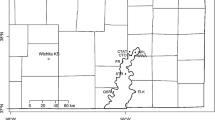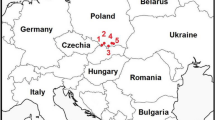Abstract
A structural description of a 0.5 ha stand in the primaeval coniferous forest of Fiby in central Sweden is reported, and a simulation model is used to test the hypothesis that the diameter and height distributions of the two most important tree species Pinus sylvestris L. (shade-intolerant) and Picea abies (L.) Karst. (shade-tolerant), are the outcome of simple successional processes following storm-felling 190 yr previously. The simulation model, FORSKA, is a ‘gap model’ treating light and other resource availability as homogeneous within patches. Simple formulations of dimensional relationships, vertical leaf area distributions within trees, light attenuation through the canopy and net assimilation as a function of ligh intensity allow FORSKA to simulate the species mixture, size distributions and vertical canopy structure of mixed-age, mixed-species forests. Parameters of the model were estimated from literature and from field data on height-diameter relationships, establishment rates and maximum ring-widths. The simulation generated a stand description similar to the real one in all essential characteristics. FORSKA allows vertical overlap between the crowns of nearby trees. The present simulation also differed from many gap model simulations in that the patch size was much greater than the maximum crown size, consistent with field observations that single treefall gaps have little effect; the persistence of shade-intolerant species in boreal forests generally depends on larger-scale disturbance events, such as large storm-gaps and forest fires.
Similar content being viewed by others
References
Ågren G. I., 1983. Nitrogen productivity of some conifers. Can. J. For. Res. 13: 494–500.
Albrektsson, A., 1980. Tallens biomass: storlek — utveckling — uppskattningsmetoder. Sveriges Lantbruksuniv. Inst. för Skogsskötsel, Rapp. 2, 189 pp.
Botkin D. B., Janak J. F. & Wallis J. R., 1972. Some ecological consequences of a computer model of forest growth. J. Ecol. 60: 849–873.
Canell M. G. R., 1982. World forest biomass and primary production data. Academic Press, New York.
Daniel T. W., Helms J. A. & Baker F. S., 1979. Principles of silviculture. 2nd ed. McGraw-Hill, New York.
Fuchs M., Schulze E. D. & Fuchs M. I., 1977. Spacial distribution of photosynthetic capacity and performance in a mountain spruce forest of northern Germany. II. Climatic control of carbon dioxide uptake. Oecologia 29: 329–340.
Hytteborn H., 1975. Deciduous woodland at Andersby, eastern Sweden, above-ground tree and shrub production. Acta Phytogeogr. Suec. 61: 1–61.
Hytteborn H. & Packham J. R., 1985. Left to nature: forest structure and regeneration in Fiby urskog, Central Sweden. Arboricult. J. 9: 1–11.
Jarvis P. G. & Leverenz J. W., 1983. Productivity of temperate deciduous and evergreen forests. In: O. L.Lange, P. S.Novel, C. B.Osmond & H.Ziegler (eds), Physiological plant ecology IV, pp. 234–261. Springer, Berlin.
Ker J. W. & Smith J. H. G., 1955. Advantages of the parabolic expression of height-diameter relationships. For. Chron. 31: 235–246.
Kira T., 1975. Primary production of forests. In: J. P.Cooper (ed.), Photosynthesis and productivity in different environments, pp. 5–40. Cambridge University Press, Cambridge.
Leemans R., 1986. Structure of the primaeval coniferous forest of Fiby. In: J.Fanta (ed.), Forest dynamics research in western and central europe, pp. 221–230. Wageningen. PUDOC, Wageningen.
Linder, S. & Lohammer, T., 1981. Amount and quality of information on CO2-exchange required for estimating annual carbon balance of coniferous trees. In: S. Linder (ed.), Understanding and predicting tree growth Stud. For. Suec. 160: 73–87.
Meyer H. A., 1940. A mathematical expression for height curves. J. For. 38: 415–420.
Nakashizuka T., 1983. Regeneration process of climax beech (Fagus crenata Blume) forests. III. Structure and development of sapling populations in different aged gaps. Jap. J. Ecol. 33: 409–418.
Nihlgård B. & Lindgren L., 1977. Plant biomass, primary production and bioelements of three mature beech forests in south Sweden. Oikos 28: 95–104.
Prentice I. C., 1986a. Some concepts and objectives of forest dynamics research. In: J.Fanta (ed.), Proc. Forest dynamics research in western and central europe, pp. 32–41. Pudoc, Wageningen.
Prentice I. C., 1986b. The design of a forest succession model. In: J.Fanta (ed.), Forest dynamics research in western and central europe, pp. 253–256. Wageningen, PUDOC, Wageningen.
Reichle D. E., 1981. Dynamic properties of forest ecosystems. Cambridge University Press, Cambridge.
Sernander R., 1936. Granskär och Fiby urskog, en studie över stormluckornas och marbuskarnas betydelse i den svenska granskogens regeneration. Acta Phytogeogr. Suec. 8: 1–232.
Shugart H. H., 1984. A theory of forest dynamics. Springer, New York.
Shugart H. H. & West D. C., 1977. Development of an Appalachian deciduous forest succession model and its application to assessment of the impact of the chestnut blight. J. Envir. Managem. 5: 161–179.
Shugart H. H. & West D. C., 1979. Size and pattern of simulated forest stands. For. Sci. 25: 120–122.
Sjörs H., 1965. Forest regions. Acta Phytogeogr. Suec. 50: 48–63.
Solomon, A. M., Tharp, M. L., West, D. C., Taylor, G. E., Webb, J. W. & Trimble, J. L., 1984. Response of unmanaged forests to CO2-induced climate change: available information, initial tests, and data requirements. U.S. Dep. Energy, Techn. Rep. 009, 93 pp.
Troeng E. & Linder S., 1982. Gas exchange in a 20-year old stand of Scots pine. II. Variation in net photosynthesis and transpiration within and between trees. Physiol. Plant. 54: 15–23.
Trorey L. G., 1932. Mathematical expression for the construction of diameter-height curves. For. Chron. 18: 3–14.
Author information
Authors and Affiliations
Additional information
This research was partly supported by a grant from NFR (Swedish Natural Science Research Council) to the project ‘Simulation modelling of natural forest dynamics’. We thank Hank Shugart for discussions leading to the development of the simulation model.
Rights and permissions
About this article
Cite this article
Leemans, R., Prentice, I.C. Description and simulation of tree-layer composition and size distributions in a primaeval Picea-Pinus forest. Vegetatio 69, 147–156 (1987). https://doi.org/10.1007/BF00038696
Accepted:
Issue Date:
DOI: https://doi.org/10.1007/BF00038696




